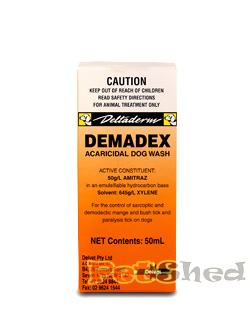Canine Demodectic Mange: Diagnosis And Treatment

Demodectic mange is a skin disease caused when a mite called Demodex, which usually is relatively harmless, proliferates and overpopulates the skin of its host animal.
Demodex diagnosis
Diagnosis of Demodex is most commonly by demonstration of mites in deep skin scrapings. Any dog with possible demodicosis should be scraped, which may require sedation or general anesthesia.
Because D. canis mites live deep in the hair follicle, the veterinarian will often squeeze the skin (like a pimple) before scraping in an attempt to push mites out from the follicles. The hair is usually clipped from the site, then a scalpel blade with a little mineral oil is scraped across the skin until it just begins to bleed. The skin and debris collected on the scalpel blade are wiped onto a slide and examined under a microscope by the veterinarian.
It is possible that no mites will be seen on the skin scrape even when the dog has the disease, particularly in Old English Sheepdogs, Scottish Terriers and Sharpeis, which are thought to have deeper hair follicles than other breeds.
Feet and faces are difficult to scrape, so plucking the hair from these areas is sometimes tried instead in the hope of dislodging mites from the hair follicle. Occasionally, skin biopsies are also attempted to locate the mites.
Demodex treatment
The canine localized form of the disease will normally clear up spontaneously, however weekly parasiticidal dips may be beneficial in speeding recovery.
|
"Treatment has no guarantee of success, and even if treatment is successful initially, relapses can occur."
|
The prognosis for recovery from generalized demodicosis is guarded. Treatment has no guarantee of success, and even if treatment is successful initially, relapses can occur, normally within six to 12 months of the initial occurrence. Successful treatment depends on the severity of the secondary bacterial infection, the immune status of the dog and owner compliance. Some cases can be controlled, but not completely cured.
Due to the genetic basis of the disease, animals should be desexed when the disease is brought under control to prevent them passing it on to future generations. In females particularly, coming into heat and pregnancy can be stressful on the body and cause a relapse.
Treatments include:
-
Amitraz, in products such as Demadex Acaricidal Dog Wash and Mitaban dip. Dipping is the primary treatment and should be repeated every two weeks until no mites are found on deep skin scrapings, which should be repeated monthly. Treatment should continue for four weeks after scrapings show no mites. This may take several months.
- Dipping is most effective if preceded by a shampoo, preferably one containing benzoyl peroxide, which flushes the follicles to encourage the mites to move towards the skin surface. Ideally, animals should also be clipped of hair prior to treatment. The dip solution should be diluted to the appropriate strength with water, then applied with a sponge to ensure the animal is thoroughly wet. After application, the dog should not be rinsed or towel dried but air-dried or dried with a blow drier. These dips can be toxic so great care should be taken when using them.
If mite numbers have not decreased or lesions have not cleared after several weeks, alternative therapies should be considered. These are all off-label, but veterinarians may prescribe some, including increasing the concentration or frequency of amitraz treatments or utilizing milbemycin oxime or ivermectin for prolonged periods.
Treatment protocols should include antibacterial treatment for any skin infections but not anti-inflammatory medication as this will suppress the dog's immune system even further.
�
�
�
|
References
|
| Payne, P.A., Dryden, M.W., Carter,G.R. External Parasitic Diseases of Dogs and
Cats. In: A Concise Guide to Infectious and Parasitic Diseases of Dogs and Cats International Veterinary
Information Service, Ithaca NY. www.ivis.org Tilley, L.P., Smith, F.W.K. The Five Minute Veterinary Consult Canine and Feline. Second Edition. Lippincott Williams & Wilkins, Baltimore, 2000. Demodectic Mange. www.maristvet.com |
Mitaban� is a registered trademark of Pfizer Inc.